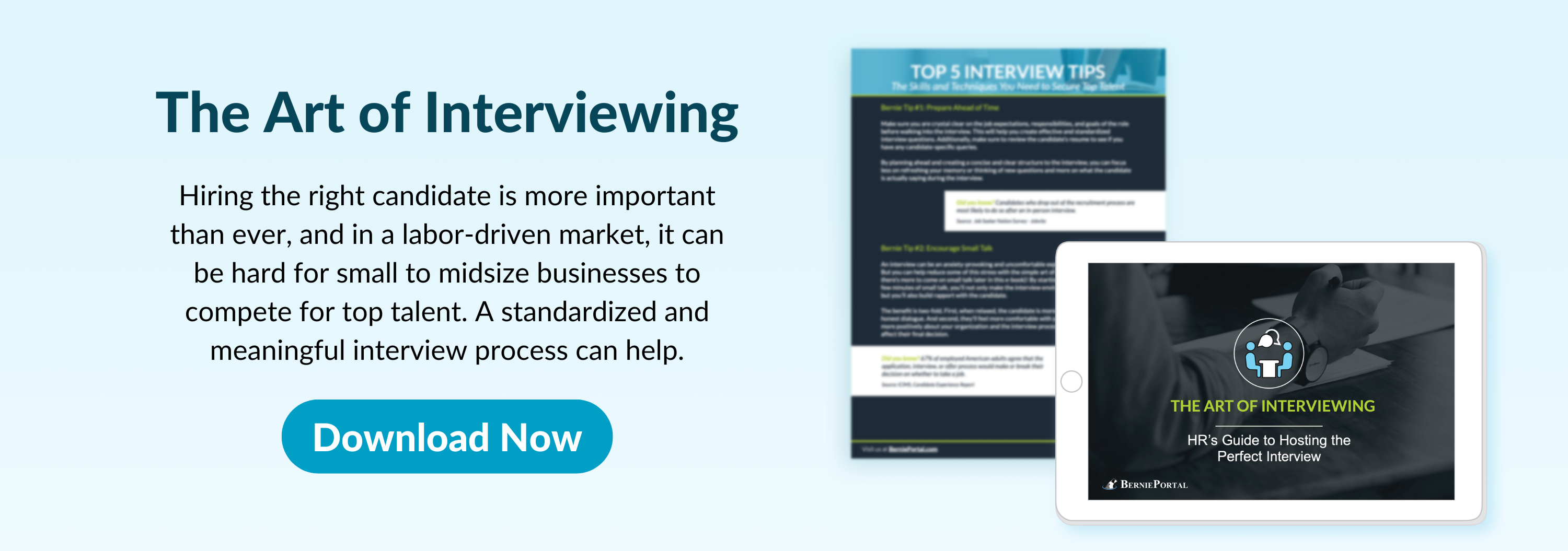Written by
Will Miranne
Will is an aPHR-certified writer on the marketing team at BerniePortal. He writes about healthcare, human resources, and benefits.
How to Hire For a New Position

Employers often find the need for a new position within their organization. But that role has never existed, meaning success has never been measured.
Read on to learn more about the struggles associated with hiring for newly created positions and what you can do to ensure you hire the right people for your organization.
→ Not enough hours in the day for all of your HR needs? Improve your strategy today with BerniePortal. Click here now for a free demo!
What Are the Challenges of Hiring for New Roles?
Hiring for new roles that lack specific metrics for success can be challenging for organizations. Some of the concerns organizations may face include the following:
-
Lack of clarity: When there are no specific metrics for success, it can be challenging to determine what success in the role looks like. This can lead to a lack of clarity regarding what the organization is looking for in a candidate and what the candidate should expect from the role.
-
Risk of hiring the wrong person: Without ways to determine success, it can be difficult to evaluate candidates effectively. This can increase the risk of hiring the wrong person for the role, resulting in poor performance, low productivity, and other adverse outcomes.
-
Difficulty in setting expectations: When metrics are vague, it can be challenging to set expectations for the role, making it exceedingly difficult to define key responsibilities, performance goals, and other needed metrics for success.
-
Inability to measure success: unclear metrics make it difficult to measure whether the new hire is performing well in the role. This can make it challenging to identify areas for improvement and track progress over time.
-
Lack of alignment: Without clear metrics for success, it can be challenging to ensure that the new role is aligned with the organization's overall strategy and goals. This can lead to a lack of clarity around the purpose of the role and how it contributes to the organization's success.
Hiring for new roles is critical for organizations to do correctly. When those roles lack specific metrics for success, organizations can find themselves with numerous problems to figure out.
Organizations must proactively define expectations for roles, provide clear feedback, offer support options to new hires, and maintain clear methods for measuring progress against key performance indicators. By doing so, organizations can increase their chances of hiring the right person for the role and ensure that the new role is aligned with their overall strategy and goals.
How Should Organizations Set Expectations for New Roles?
Setting expectations for new roles can be challenging for organizations, especially when they are not sure what success in that role will look like.
Here are several steps organizations can take to set clear expectations for new roles, even when they lack a clear definition of success.
- Conduct a job analysis: A job analysis involves collecting information about a job. This process involves identifying the knowledge, skills, and abilities required to perform the job successfully. By conducting a job analysis, the organization can better understand what the job entails and what is required to succeed in that role.
- Standardize the interview process: Having a standardized interview process for all candidates is essential. This can include asking the same questions to all candidates, using a structured interview format, and having multiple interviewers to ensure consistency in the evaluation process. By doing so, the organization can ensure that all candidates are evaluated based on the same criteria.
- Define the key responsibilities and expectations: Based on the job analysis, the organization can define the key job responsibilities and expectations. These should be clearly communicated to the candidate during the interview process and reiterated upon hiring. This can include performance goals, deadlines, and other relevant metrics.
- Provide clear feedback and support: Once the candidate is hired, it is crucial to provide regular feedback and support. This can include regular check-ins to discuss progress and provide feedback on performance. It is important to provide constructive feedback that is specific and actionable.
- Encourage ongoing learning and development: Organizations can set clear expectations for continuous learning and development by providing training opportunities. This can include on-the-job training, mentorship programs, and other professional development resources.
How Can Employers Set Standards for The Hiring Process?
Setting the correct standards for the hiring process is critical to ensuring organizations are hiring the best people for the job. Establishing clear guidelines and procedures allows employers to create consistent and fair strategies for evaluating candidates and hiring decisions.
This can include guidelines on how to conduct interviews, what questions to ask, and how to evaluate candidates. Standardized interview processes can help ensure that all candidates are assessed based on the same criteria and that hiring decisions are made fairly and objectively.
Additionally, all hiring managers should be trained to evaluate candidates fairly and avoid unconscious bias in the hiring process.
In situations where the success markers for a new role are not clearly defined, employers should still establish standards for the hiring process. This can include setting clear expectations for the role, defining the key responsibilities and expectations, and establishing relevant metrics for success.
Employers should also define the qualifications and experience required for the role and communicate that information to all candidates. This can be done by establishing clear communication channels with new hires—BerniePortal’s Applicant Tracking tool, for example.
Setting standards for the hiring process is an essential aspect of hiring the right people for the job. By establishing clear guidelines and procedures, employers can create a consistent and fair process for evaluating candidates and making hiring decisions. This can help organizations attract and retain top talent and ensure that they hire people aligned with their overall strategy and goals.
Additional Resources
You can also stay informed, educated, and up-to-date with all things HR by using BerniePortal’s comprehensive resources:
- BernieU—free online HR courses, approved for SHRM and HRCI recertification credit
- BerniePortal Blog—a one-stop-shop for HR industry news
- HR Glossary—featuring the most common HR terms, acronyms, and compliance
- HR Guides—essential pillars covering an extensive list of comprehensive HR topics
- HR Party of One—our popular YouTube series and podcast, covering emerging HR trends and enduring HR topics
Written by
Will Miranne
Will is an aPHR-certified writer on the marketing team at BerniePortal. He writes about healthcare, human resources, and benefits.
Related Posts
Thomas J. Peters, best known for his book In Search of Excellence, once stated, “The day...
The first impression an employer makes is just as important (if not more important) than...
Organizations usually take one of four major approaches when talking about pay.
SHRM states that for HR, overlooking social media today would be like “ignoring e-mail 20...








Submit a Comment